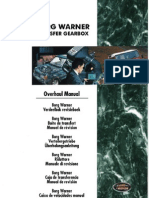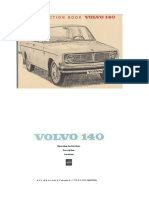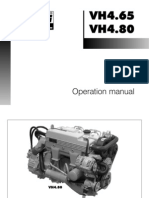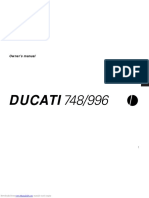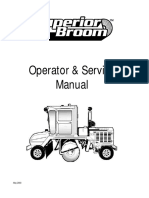Tomos User Manual
Tomos User Manual
Uploaded by
MahoneyCopyright:
Available Formats
Tomos User Manual
Tomos User Manual
Uploaded by
MahoneyOriginal Title
Copyright
Available Formats
Share this document
Did you find this document useful?
Is this content inappropriate?
Copyright:
Available Formats
Tomos User Manual
Tomos User Manual
Uploaded by
MahoneyCopyright:
Available Formats
Revival
USER'S MANUAL
BEDIENUNGSANLEITUNG
HANDLEIDING
MANUEL D'UTILISATION
Downloaded from www.Manualslib.com manuals search engine
CONTENTS
Warnings 3 Cleaning 14
Riding Safety Tips 3 Fuel System Cleaning 14
Technica1 Specifications 4 Exhaust System Cleaning 15
Technical Description 6 Vehicle Cleaning 16
Vehicle Operation 9 Checks and Adjustments 16
Fuel 9 Engine Oil Level Check 16
Engine Starting 9 Bowden Adjustment 16
Riding 11 Transmission Chain Adjustment 17
Engine Running-Jn 11 Bolt and Nut Tightness 18
Luggage Space 11 Maintenance Schedule 19
Maintenance 12 Battery Installation 20
Maintenance Operations 12 Troubleshooting 21
Lubricants 12 Fuel System Troubles 21
Gearbox Oil Change 12 Ignition System Troubles 21
Changing and Checking Brake Pads 13 Troubles Causing Reduced Engine Power 21
Changing and Checking Brake Fluid 14 Gearbox Troubles 22
Fuse Replacement 14 Electrical System Diagram FULL OPTIONAL 23
Electrical System Diagram STANDARD 24
Downloaded from www.Manualslib.com manuals search engine
WARNINGS No modifi cat ion of the vehicle, stripping- off of any parts or installing
of non-miginal spare parts is permitted. The vehicle owner is spe cifi ·
Prior to operating the vehicle, car efully read this User's Manual in cally warned that any modification to the exhaust system can only
order to get acq uai nted with its operational characteristics and safe result in the vehicle's deteriorated operation, •.'lithout any positive
and proper operation. effects on engine performance.
1. Fuel is extremely flammable and explosive; ther efore it requires RIDING SAFETY TIPS
special handling precautions:
· stop the engine prior to refilling the tank: Riding a two-wheeler is simple, yet it requires some skills and experi·
· fill the tank outdoors; never approach the tank with a lit cigarette, ence which can only be accumulated progressively. Prior to each ri d e,
open flame or sparks; a nd observe the following rules:
· th oro ughly v1ipe offa n y spilled fuel .
2. The engine s hould not be run in an e nclosed space or nearby 1. Check the proper functioning of all vehicle assemblies.
entrances to lower·level areas (cellars etc.). Engine exhaust gases 2. When r idi ng, wear light-colored, preferably light-reflective clothes;
are toxic and denser than normal atmospheric ai r. ride with y ou r lights on; avoid riding in other drivers' "blind spots"
3. When starting or running t he engine, never touch the ignition coil, to prevent the danger of other driv ers "over looking" you.
high-voltage cable. ignition spark plug cap or other parts of the 3. Abide by all traffic regulations; above all, adjust your riding speed
electrical system. t o the road con di tions and your skill leve l.
4. When the eng in e is running and for some time after it has stopped 4. Do not hand the vehicle over to any inexperienced riders.
do not touch its hot parts: the cylinder, the cylinder head, the 5. Prior to c hanging direction, always check that this can be done
exhaust si le nce r or brake components. safely, and signal your intention in time. Be careful when riding
5. When the engine is running bei�are of the engine's rotating parts. thro ugh road crossings or passing other vehicles (including parked
v ehicl es).
Downloaded from www.Manualslib.com manuals search engine
6. Always ride with your helmet on, be properly dressed and wear TECNICAL SPECIFICATIONS
boots.
7. Pay due attention to what is going on in front ofyou and behind
you (rear mirror) and try to anticipate events.
8. The braking method affects the loading on each wheel: the front Model REVIVAL Standard, Full optional
brake increases the effect of braking, whereas braking with the
rear brake only increases the braking distance while also reducing Engine Type single-cylinder, two·stroke.
vehicle stability; hence use the rear brake with due caution. alr·cooled
Displacement 49 cc
Cylinder bore diameter 38 mm
Piston stroke 43 mm
Compression ratio 10:1
Engine capacity 1.5 kW at 5000 min 1
Torque 3,5 Nm at 2800 min·1
Maximum road speed 30 mph
Maximum gradient, wi t h
an 180 lbs load 20%
Starter Electric (FULL OPTIONAL) 12V 170W
Pedal starter
Fuel Tank capacity 1 gal (O.l gal reserve)
Engine o il reservo ir 0.2 gal
Fuel consumption 100+ miles per gallon
Downloaded from www.Manualslib.com manuals search engine
Suspension Front shock absorber travel 7omm Direction indicator signal light 12V1.5W
Rear shock absorber travel 4 o mm Oil level indicator light 12V1.5W
Low beam headlamp indicator light 12V1.5W
Wheels Front tire dimensions 2 1/2-17" Main beam headlamp i ndicator light 12V I.SW
Rear tire dimensions ?3/4-16" Battery (FULL OPTIONAL) 12V 4Ah
Front tire inflation pressure 41 PSI Fuse (FULL OPTIONAL} 8A
Rear tire inflation pressure 41 PSI
Dimensions �Jheelbase 1195mm
Electrical Magnetic ignition coil 12V 80W and weights Total length of vehicle 1825 mm
system Spark advance 1.5 mm prior toTDC Vehicle mass (empty fuel tank) 18olbs
Ignition spark plug Bosna F75 Maximum permitted total weight 350 lbs
Spark plug electrode clearance o.Smm
Headlight 12V 35W/35W +
12V/4\.J side lamp
Tail light 12V 51.J +
12V/10H stop lamp
Instrument illumination 12V 2W
Direction indicalors !2V IOW
Downloaded from www.Manualslib.com manuals search engine
TECHNICAL DESCRIPTION
I. Rear brake pedal 20. Oil reservoir
2. Direction indicator switch 2L Fuel tank cap
3. Horn s��tch 22. Air filter
4- Main beam/101-1 beam switch 23.Chokelever
5. Ignition switch (FULL OPTIONAL) 24- carburetor
6. Battery and fuse (FULL OPTIONAL) 25. fuel filling vent
7. Speedometer 26. fuel shut·off cock
8. Luggage carrier 27. Handlebar lock
9. Brake fluid reservoir (FULL OPTIONAL) 28. Starter pedal
10. light switch 29. Seat lock
11. Electric start pushbutton (FULL OPTIONAL) 30. Oil reservoir cap
12. Throttle lever 31. luggage space (8) opening button
23. Front brake lever
14· Direction indicator signal light
25. Oil level indicator light
26. Main beam indicator light
27. Low beam indicator light
18. Oil pump
29. Luggage space
Downloaded from www.Manualslib.com manuals search engine
2,3,4 5 6 7 8 9 10, 11 12 13
g. 1
. ig. 2 14 15 16 17 Fig. 3
Downloaded from www.Manualslib.com manuals search engine
18 29
Fig. 4 Fig. 5
Downloaded from www.Manualslib.com manuals search engine
VEHICLE OPERATION
Fuel
Regular+ two-stroke engine oil, in the ratio 1:50 (2%).
The moped is equipped with an oil pump that admixes, in d ep endentl y
of the engine rotation sp eed, oil to the fuel as speciAed for two
stroke engines (2%).
CAUTION!
Prior to starting the engine for the first time, fill the fuel tank
(21, Fig 5) with approx. t liter of two-stroke engine oil and gasoline mix
ture, in the ratio of 1:50 (2%), then start the engine and let it run for
10
at least 5 minute s in order to allow the oil pump to fill t he suction pipe.
[_ -· -
11 Prior to the above operat ion, remove the oil pump cap (18, Fig.S) and
release the venting boll (A, Fig. 5) and wait for the oil to emerge from
the reservoir located under the seat Then retighten the bolt
Fill the moped's fuel tank with gasoline and ensure that the oil reser
voir level never drops below the low limit mark (20, fig 5). Also ensure
that the oil supply pipe is not twisted sharply.
Engine Starting
Enter the key in the ignition switch (S, Fig. l) and turn it to the ON
Fig. 6 position. Switch on the light s1vitch (10. Fig. 6).
Downloaded from www.Manualslib.com manuals search engine
Open the fuel shut-off cock (Fig.7}. Note: A· fue l supply shut-off. B -
fuel supply on, C reserve
•
If the engine is cold. press the choke lever (B, Fig.8).
tvith the throttle fully closed, press the rear brake pedal and press the
electric start lever (11, Fig. 6) (FULL OPTIONAL) or start the engine by
using the starter pedal (28, Fig. 4) (without opening the throttle).
Caution: If the engine foils to start. release the starter lever. This
prevents the battery from draining. Do not keep the engine start
lever depressed longer than 5 seconds. Should the electric starter fail
to start the engine or ifyour moped is not equipped with an electric
starter, start the engine by using t he starter pedal.
\�hen using the choke lever. allow the engine to run for 10 to 20 sec
onds vlithout opening the throttle. The choke lever disengages auto
matically when the throttle is opened.
!n the case the engine is hot. do not use the choke lever.
Fig 7
.
10
Downloaded from www.Manualslib.com manuals search engine
Riding
The speed is controlled by the throttle lever (12, Fig. 1). Engaging the
first or second gear is done by opening or closing the throttle. Avoid
switching too frequentl.Y between first and second gears. In such situa
tions-;-yoa should instead reduce the throttle opening and keep the
vehicle in first gear. When descending a slope, shortly open the throttle
from time to time, in order to improve lubrication and headlight opera
tion. The vehicle is shut down by closing the throttle lever and switch
B ing the lights off (10, Fig. 6). Then, close the fuel shut-off cock (position
A. Fig. 7). If the vehicle is to stay out of operation for a longer period
(e.g. during winter), draining of the fuel from the carburetor cup in the
following way is recommended: close the fuel shut-off cock and, by
A opening the throttle lever, let the engine run out automatically.
Engine Running-In
During the initial 60 miles, do not run the engine at full throttle.
Later, increase the engine loading progressively.
Luggage Space
Luggage space is provided to the right-side part of the tank housing
(8) and under the seat (19). To open it, insert the key in the seat
switch and turn it. Under the seat, a tank opening lever is located.
Fig. 8 The tank is opened by pulling the lever.
11
Downloaded from www.Manualslib.com manuals search engine
Caution: system) and checking of safety-related riding components (tire pres·
1. When operating the engine in conditions of high ambient tempera sure, operation of lights and brakes, tightness of bolts and nuts). The
tures, the temperature in the luggage space rises considerably. maintenance schedule specifies maintenance operations and their
Therefore, do not store temperature-sensitive objects in the lug time intervals, on the assumption of average distance traveled of
gage space. 3,000 miles a year.
2. Do not store important or delicate objects in the luggage space.
3. In the rain or during washing the luggage space may get wet Lubricants
4. Before leaving the moped unattended, close the luggage space and For the gearbox, apply the automatic gearbox oil: ATF A or ATF 82. F-or
remove the key. lubrication of other vehicle components (see the maintenance sched·
ule), application of SAE 30 grade engine oil and LIS 2 grease is recom·
Caution: Keep the key code number plate in a safe place. Do not keep mended.
it together with the key. Should you lose both keys, submit a request
for replacement keys, complete with the code number, to the nearest Gearbox Oil Change
authorized service and the replacement keys will be provided as soon Oil should be changed when the engine is still warm. Remove the right
as possible. side shield, release all three threaded plugs (1, 2, 3. Fig.9} on the right
side of the engine casing, and let the oil drain completely. Retighten
MAINTENANCE oil draining plug (3, Fig. 9) and pour approx. 10 fluid ounces of oil
through the refilling opening (1, Fig. 9), so that the oil level reaches
Maintenance Operations the control opening (2, Fig.g). Then, retighten the oil refilling and con
The vehicle is easy to maintain, yet maintenance is imperative for per trol opening plugs.
fect performance. Particularly important operations include regular
lubrication of individual assemblies, gearbox oil changes, cleaning of
parts affecting engine operation (spark plug, exhaust system, fuel
12
Downloaded from www.Manualslib.com manuals search engine
A
Fig. 9
Changing and Checking Brake Pads (Disc Brake Model)
Brake pads are checked visually. As soon as the brake pad wear reach
es the grooves (A, Fig. 10), the pads should be replaced by an author
ized service agent. Check the brakes for any grease smears. In the
case you notice such smears, take the vehicle immediately to an
authorized service agent for examination and repair. Fig. 10
13
Downloaded from www.Manualslib.com manuals search engine
Changing and Checking Brake Fluid (Disc Brake Model) is blown, turn the ignition switch (5, Fig. 1) to the OFF position.
Replace the fuse with a new one of the correct specifications. Return
The brake fluid reservoir is attached to the right side of lhe steering the ignition switch to the ON position and check operation. If the new
handlebar (13, Fig. 1). With new brake pads, the fluid level should be fuse blows as well, have the electrical circuitry examined by an
approx. 5 mm below the reservoir lid. To change or top up brake fluid, authonzed service agent
remove the two reservoir cap bolts. top up the brake fluid, and
release any air from the brake system by repeated depressing of the Caution: Do not install a fuse with a higher capacity than specified. An
brake lever. When changing or topping up, use hydraulic brake system incorrect fuse could seriously damage the electrical system or even
fluid (U 2). cause a fire.
CLEANING
Fuel System Cleaning (Fig. 12)
As regards the fuel system, periodic cleaning of the main nozzle.
strainer under the carburetor intake connection, air filter, and shut
off cock strainer is required. Do not use metal objects to clean the
main nozzle; clean it with an air jet
Fig. 11
Filter - sponge C should be washed thoroughly in gasoline. After wash
Fuse Replacement ing. squeeze gasoline from the sponge (do not brush it!) and dry the
sponge in a dry air jet Then, soak the sponge with SAE 20-50 oil.
The fuse is located in the luggage space (8, Fig. 5). Open the luggage Finally. squeeze oil (without brushing!) from the sponge so as to leave
space on the right-side part of the tank housing (8, Fig. 5). If the fuse only a thi n layer of oil on the sponge.
14
Downloaded from www.Manualslib.com manuals search engine
Exhaust System Cleaning (Fig. 13)
The build up of soot in the exhaust system obstructs the free passage
-
of exhaust gas and thereby reduces engine power. Unscrew the bolt at
the exhaust pipe's rear end, pull the silencer out and clean it free of
soot
Periodically, clean the cylinder exhaust duct exhaust pipe inlet open
,
ing. piston cro;�n and cylinder compression chamber (Fig. 14).
fig. 12 Fig.13
15
Downloaded from www.Manualslib.com manuals search engine
CHECKS AND ADJUSTMENTS
Engine Oil Level Check
Regularly check the oil level in the reservoir under the seat. Top of as
required. Should the warning light fail to extinguish after starting the
engine, this means the oil level is low and immediate topping up is
required. The warning light should come on when you turn the ignition
switch to the ON position. If it does not, the fault should be remedied.
Bowden Adjustment
Bowden brakes are adjusted by means of the wheel hub bolt (A, Fig.16).
The Bowden is properly set when the handlebar levers' free travel is 10
to 15 mm and the sleeve· lever gap is approx. 3 mm (Fig. 15}. After
adjusting, make sure you retighten the jam nut
Fig. 14
Vehicle Cleaning
Vehicle exterior cleaning is also part of regular maintenance. After
washing, wipe the vehicle dry. Protect painted surfaces with paint pro
tection agents. After cleaning, check the operation of the engine, the
lights and the brakes.
16
Downloaded from www.Manualslib.com manuals search engine
3mm
Fig. 16
Transmission Chain Adjustment
The chain tension should be adjusted so that the chain yields 10 mm
up or down under pressure (Fig. 16). Adjust the chain tension by spin
ning the chain tensioners on the rear wheel axis (B, Fig. i6). After the
adjustment, retighten the wheel axis nuts that were partly released
Fig. 15 for the adjusting.
IJ
Downloaded from www.Manualslib.com manuals search engine
iomm
iomm
Fig. 17
Bolt and Nut Tightness
Periodically check and retighten as necessary the bolts and nuts of
the main vehicle components (wheels, handlebar, rear shock
absorbers, rear fork a xis, engine to frame bolts, gearbox oil drain
plug).
1A
Downloaded from www.Manualslib.com manuals search engine
MAINTENANCE SCHEDULE
interval (miles) 300 1000 2000 3000 interval (miles) 300 1000 2000 3000
interval (months) 2 3 6 12 interval (months) 2 3 6 12
Oil lubrication Checks and adjustments
L GearbOx oil change • • • • 12. Gearbox oil level • • • •
2. Bowdens (internal cable) as ne cessary 13- Brake p ads • • • •
3. Chain • • • • 14. Ho rn and lights • • • •
15. Spark advance angle • • • •
Greasing 16. Spark plug electrod e clearance • • • •
4. Front fork sliding tubes • • 17. Brake operation check and adjustment • • • •
5. Rear fork bearing boxes as necessary 18. Handlebar bearing clearance • • • •
6. Handlebar bearings • 20. Wheel track • •
21. Tire pressure (front & rear: 41 PSI) • • • •
Cleaning 22. Chain tension (10 mm up - 10 mm down) • • • •
7. Spark plug as necessary 23. Idle run and throttle • • • •
8. Air cleaner (oiling) • • • 24- Bolt and nut tightness • • • •
9. Cylinder head. piston head. exhaust duct • •
10. Exhaust silencer • •
n. Cylinder and exhaust pipe • •
19
Downloaded from www.Manualslib.com manuals search engine
BATTERY INSTALLATION
Open the luggage space on the right part of the tank housing
(8, Fig. 1). Release the two bolts of the lift-side part of the tank.
Place the battery sideways on the ribs. with the c onn ection shoes fac
ing upwards, pull the installed rubber band (A, Fig. 18) over the bat
tery and fix it to the clip (B. Fig. 18) installed on the center rib.
Applying the bolts supplied with the battery, connect the blue color
electric cable to the blue color battery connection shoe (-),and t he
red color electric cable to the r ed color battery connection shoe(+).
Caution: When closing the left-side part of the tank housing, make
sure the cables are laid in properly.
Fig. 18
20
Downloaded from www.Manualslib.com manuals search engine
TROUBLESHOOTING · Wet spark or electrodes in a short circuit:
· Spark plug electrodes frequently in a short circuit:
Fuel System Troubles clean soot build-up from the cylinder head and piston head.
Possible causes of the engine failing to start or stopping during a ride - Spark plug electrodes are worn out:
include: adjust the electrode clearance according to the specifications. or
replace the spark plug with a new one.
- Fuel is not supplied to the carburetor: ·Spark plug cap improperly mounted or short-circuiting to the
check the fuel tank level and the position of the shut-off cock. ground mass:
· Clogged fuel strainers: properly mount the cap on the spark plug or replace with a new cap.
blm� the strainers clean. · Faulty capacitor or ignition coil:
·Clogged main carburetor nozzle: have the trouble examined and remedied by an authorized service
remove and blo1� clean. agent
- Improper use of the choke lever:
use the lever in accordance with the engine start instructions. Troubles Causing Reduced Engine Power
- Low engine idle speed setting: Possible causes of reduced engine power and reduced vehicle road
using the adjustment bolt (A. Fig. 8), increase the engine speed; performance include:
improper functioning of the Jamel valve · the fault should be reme·
died by an authorized service agent · Inadequate spark plug or cylinder head tightness:
tighten the spark plug or the cylinder head nuts.
Ignitio n System Troubles · Clogged air cleaner on the carburetor:
Check the spark. Possible causes of the ignition spark plug failing to Wash in gasoline, blow dry and oil lightly.
produce a spark include: · Clogged exhaust system: clean.
21
Downloaded from www.Manualslib.com manuals search engine
· Wheel brakes do not disengage completely: - After engaging the second gear, the clutch jerks:
oil and a d jus t the Bowdens bra ke. chain is too loose • adjust the chain's tension;
• Improper setting of spark advance angle: - Low gearbox oil level - top up to the specified level.
have it adjusted by an authorized service agent - With the engine shut down, it is difficult to move the vehicle for-
· Worn out or broken rings: wards-ba ckwards:
have them replaced by an authorized service agent. have the trouble examined by an authorized service agent.
Gearbox Troubles
· Following the start, the engine runs at idle speed. If opening the
lhrolUe fails to engage the clutch: release the throttle and attempt
lo start the vehicle again (the oil is still cold and thicker). When rid·
ing, open the throttle gradually to prevent engine jerks. If the prob·
!em is frequent, have it repaired by an authorized service agent
·The clutch slides (particularly in cold weather):
improper oil type in the gearbox · change with the specified oil.
· The clutch takes excessively long to switch to the second gear or
does not swi tch a t all:
reduced engine p ower clean the exhaust silencer;
·
the clutch is stuck try to activate the clutch at highe r engine revs.
·
with the vehicle propped up on a stand;
excessive amount of oil in the gearbox - check the oil level.
· Br ak es do not disengage completely· lubricate the Bowdens.
22
Downloaded from www.Manualslib.com manuals search engine
Electrical System Diagram
FULL OPTIONAL
L Left direction indicator lamp 19. Ignition switch
2. Right direction indicator lamp 20. Starter
3. Horn 21. Starter cranking relay
4- Headlamp 22. Battery
5. Side lamp 23. Oil switch
6. Stop lamp 24. Ignition electronics
7. Instrument illumination 25. Generator
8. Direction indicator signal lamp 26. Relay
9. Main beam headlamp indicator lamp 27. AC/DC regulator
10. Low beam headlamp indicator lamp
lL Oil level indicator lamp
12. Stop lamp switch
13. Electric start pushbutton
1.4. lamp s1'iitch
15. Engine on/off switch
16. Main beam/low beam switch
17. Direction indicator switch
18. Horn switch
23
Downloaded from www.Manualslib.com manuals search engine
Electrical System Diagram
STANDARD
1. Left direction indicator lamp 19. Ignition electronics
2. Right direction indicator lamp 20. Generator
3. Horn 21. Relay
4. Headlamp 22. AC regulator
5. Side lamp
6. Stop lamp
7. Instrument illumination
8. Direction indicator signal lamp
9. Main beam headlamp indicator lamp
10. Low beam headlamp indicator lamp
11. Oil level indicator lamp
12. Stop lam p switch
13. Lamp switch
14. Engine on/off switch
15. Main beam/low beam switch
16. Direction indicator switch
17. Horn switch
18. Oil switch
24
Downloaded from www.Manualslib.com manuals search engine
FULL OPTIONAL
J 24.
25.
27.
•,
1.
ultJ
Jl CA t 710232785
\
12. 16. 17. 18.
Downloaded from www.Manualslib.com manuals search engine
STANDARD
12. 13. 14.
2.
3.
4.
7.
6.
9.
3.
\710232726
12.
Downloaded from www.Manualslib.com manuals search engine
You might also like
- Koehring ManualDocument56 pagesKoehring ManualKyle A. Nolan100% (3)
- Ta200 Owner ManualDocument54 pagesTa200 Owner ManualWan Ah-Lun100% (1)
- SMV Operators Training - Reach StackerDocument47 pagesSMV Operators Training - Reach Stackerhydro tec100% (4)
- LJ 50 QTDocument54 pagesLJ 50 QTverkacktNo ratings yet
- Regal Raptor Spyder Owner ManualDocument50 pagesRegal Raptor Spyder Owner ManualPAULO VILCHES100% (5)
- Marine Diesel Engines: Maintenance, Troubleshooting, and RepairFrom EverandMarine Diesel Engines: Maintenance, Troubleshooting, and RepairRating: 4.5 out of 5 stars4.5/5 (15)
- Genuine Buddy 50 125 150 170 Owners Manual ENDocument44 pagesGenuine Buddy 50 125 150 170 Owners Manual ENTerrence JonesNo ratings yet
- Vetus M4.15 OperationDocument72 pagesVetus M4.15 Operationchristian vergaray gonzalesNo ratings yet
- Eton Viper 70 ManualDocument40 pagesEton Viper 70 ManualLou Calabrese100% (1)
- Epico User ManualDocument54 pagesEpico User Manualhskv20025525No ratings yet
- Priority Areas For Development IncentivesDocument1 pagePriority Areas For Development IncentivesMelissa MontalvoNo ratings yet
- CF800 2 Service ManualDocument316 pagesCF800 2 Service Manualcombito6100% (1)
- Borg Warner P38Document36 pagesBorg Warner P38Joao Miguel Bernardo Saraiva100% (2)
- Racing 45 EnglishDocument23 pagesRacing 45 EnglishtomNo ratings yet
- Daelim Delfino ManualDocument47 pagesDaelim Delfino ManualflorinpetreusNo ratings yet
- Regal Raptor NAC Owner Manual PDFDocument45 pagesRegal Raptor NAC Owner Manual PDFPAULO VILCHES0% (1)
- Tornado tnt600Document64 pagesTornado tnt600Winston DavidNo ratings yet
- Rebel E NewDocument29 pagesRebel E NewJansen SebastianNo ratings yet
- SMR SXR User ManualDocument39 pagesSMR SXR User ManualGavin ChapmanNo ratings yet
- HDF 2.5 Owners Manual PDFDocument57 pagesHDF 2.5 Owners Manual PDFLara BarradoNo ratings yet
- V5 Instruction ManualDocument15 pagesV5 Instruction ManualGianluca ZapiNo ratings yet
- Brio125 Euro-IV USER MANUAL - v2Document56 pagesBrio125 Euro-IV USER MANUAL - v2agsan1955No ratings yet
- OwnersManualVF3VFAVFBVFD VF3i185Pro 20230727092754Document73 pagesOwnersManualVF3VFAVFBVFD VF3i185Pro 20230727092754sharimi adasmedsbNo ratings yet
- vetus M.4.15Document80 pagesvetus M.4.15hartley112No ratings yet
- Yanmar-EF494T-Tractor-Operators-ManualDocument81 pagesYanmar-EF494T-Tractor-Operators-ManualthaoNo ratings yet
- Hanway Motorcycle HS HC 125 Operation ManualDocument40 pagesHanway Motorcycle HS HC 125 Operation ManualpeterNo ratings yet
- Owner's Manual: BRIO 125-3Document54 pagesOwner's Manual: BRIO 125-3Romanos St.No ratings yet
- CFMoto Cf500_Cf500 a Service ManualDocument254 pagesCFMoto Cf500_Cf500 a Service ManualDavid 87150No ratings yet
- 140 OwnersHandbook1968Document63 pages140 OwnersHandbook1968fransNo ratings yet
- Monster s4rDocument86 pagesMonster s4ra.adamscb1000No ratings yet
- Vetus Diesel EngineDocument80 pagesVetus Diesel EnginestartaxisNo ratings yet
- Ducati Superbike: Owner's ManualDocument122 pagesDucati Superbike: Owner's ManualCA GDNo ratings yet
- BobberDocument47 pagesBobberandrewamer1992No ratings yet
- Manual EF494T enDocument81 pagesManual EF494T enRafaelEdisonNo ratings yet
- Downloaded From Manuals Search EngineDocument58 pagesDownloaded From Manuals Search EngineBartek OpalkaNo ratings yet
- Vetus M2-02 мануалDocument120 pagesVetus M2-02 мануалРоманNo ratings yet
- Brio 125 Owners ManualDocument45 pagesBrio 125 Owners ManualJosé CarlosNo ratings yet
- O&M Manual For 4.12TCA & 6.12TCADocument101 pagesO&M Manual For 4.12TCA & 6.12TCAniceashwin7933% (3)
- Vento PHR4i REPAIR MANUAL PDFDocument88 pagesVento PHR4i REPAIR MANUAL PDFErick HinojosaNo ratings yet
- Generador KB3800GFDocument60 pagesGenerador KB3800GFAnonymous NYymdHgyNo ratings yet
- DUCATI 748/996: Owner's ManualDocument80 pagesDUCATI 748/996: Owner's ManualMiguel HaroNo ratings yet
- Daytona 125Document48 pagesDaytona 125serg perNo ratings yet
- RA GT 125 150 Operation ManualDocument46 pagesRA GT 125 150 Operation Manualdarren walkerNo ratings yet
- Monster 696Document130 pagesMonster 696Andrew64 KotelevskyNo ratings yet
- S4R / S4Rs: Use and Maintenance ManualDocument94 pagesS4R / S4Rs: Use and Maintenance ManualRavivarman ThirunavukkarasuNo ratings yet
- Christini Awd 300 250 Manual 1Document124 pagesChristini Awd 300 250 Manual 1herrysugarNo ratings yet
- Grasshopper 721D_1992-3Document35 pagesGrasshopper 721D_1992-3reeced314No ratings yet
- S3-J Transmission (HM523)Document35 pagesS3-J Transmission (HM523)Николай КирилловNo ratings yet
- Honda Goldwing GL1100 Interstate 1981 Owners Manual-DDF6BDocument100 pagesHonda Goldwing GL1100 Interstate 1981 Owners Manual-DDF6BrgdsilvaNo ratings yet
- Peugeot 404 Owners Workshop Manual 1960-1975Document136 pagesPeugeot 404 Owners Workshop Manual 1960-1975Jonathan Bernabé González Medina100% (1)
- Operator & Service ManualDocument29 pagesOperator & Service ManualCESARALARCON1No ratings yet
- Instruction and Instruction and Instruction and Instruction and Maintenance Manual Maintenance Manual Maintenance Manual Maintenance ManualDocument25 pagesInstruction and Instruction and Instruction and Instruction and Maintenance Manual Maintenance Manual Maintenance Manual Maintenance Manualmuhammad dadang andrianNo ratings yet
- S42-3-2006 1-2t tRICICLODocument122 pagesS42-3-2006 1-2t tRICICLOFernando Gallardo UrrejolaNo ratings yet
- Service and Maintenance Manual: Downloaded From Manuals Search EngineDocument112 pagesService and Maintenance Manual: Downloaded From Manuals Search EngineAndrás SzántaiNo ratings yet
- Ariens Snowblower Engine Manual - 28 DeluxeDocument35 pagesAriens Snowblower Engine Manual - 28 Deluxemotto6No ratings yet
- Daelim Roadwin 125 FiDocument68 pagesDaelim Roadwin 125 FiRalf LoNo ratings yet
- Maintenance Schedule-W46-02bDocument14 pagesMaintenance Schedule-W46-02bzhekoNo ratings yet
- User Manual - Diesel Engine-GT2500 (Eng)Document142 pagesUser Manual - Diesel Engine-GT2500 (Eng)Rydho Putra PradanaNo ratings yet
- Caterpillar Crawler Operators Manual CT o d9Document7 pagesCaterpillar Crawler Operators Manual CT o d9Tommy JunNo ratings yet
- Interactions: Transfer of Energy: ScienceDocument11 pagesInteractions: Transfer of Energy: Scienceabegyll lolit micabaloNo ratings yet
- EE Legit TermsDocument14 pagesEE Legit TermsLester James SaingNo ratings yet
- MEPCO Online Bill CheckDocument6 pagesMEPCO Online Bill Checkameerhamza42511No ratings yet
- Reymond Clacio - PPT Generator PrincipleDocument18 pagesReymond Clacio - PPT Generator PrincipleReymond ClacioNo ratings yet
- Hamworthy Engine Room Pumps AVTP RevisionDocument4 pagesHamworthy Engine Room Pumps AVTP RevisionВиталий КоропNo ratings yet
- X382 Data SheetDocument3 pagesX382 Data Sheetpraveen.kumarNo ratings yet
- Lab Report On 5v Regulated Power Supply: Md. Tariq HasanDocument9 pagesLab Report On 5v Regulated Power Supply: Md. Tariq HasanRounok100% (1)
- Class 10 PhyDocument8 pagesClass 10 Phymd.abdulaziz522010No ratings yet
- Norma - Syn: Navigation Lights Monitoring and Control SystemDocument2 pagesNorma - Syn: Navigation Lights Monitoring and Control SystemFarid ZeblahNo ratings yet
- ChemSusChem - 2016 - Tsagkari - Early Stage Capital Cost Estimation of Biorefinery Processes A Comparative Study ofDocument14 pagesChemSusChem - 2016 - Tsagkari - Early Stage Capital Cost Estimation of Biorefinery Processes A Comparative Study ofEvans Azka FNo ratings yet
- CS-Datasheet-125K-TL-GI-E DT v1.7 J8 SAM ENDocument2 pagesCS-Datasheet-125K-TL-GI-E DT v1.7 J8 SAM ENLais Silva de AndradeNo ratings yet
- Mint 26.05.2023?Document20 pagesMint 26.05.2023?Diya AgarwalNo ratings yet
- Hindware Catalogue Compressed DLDocument146 pagesHindware Catalogue Compressed DLAyushiNo ratings yet
- Power Capacitors Installation Manual-DeC2019Document24 pagesPower Capacitors Installation Manual-DeC2019กรสกล มุทะสินNo ratings yet
- Taxing Petroleum Products - DK Srivastava Et Al - EPW - Feb 2021Document7 pagesTaxing Petroleum Products - DK Srivastava Et Al - EPW - Feb 2021Amiesha DhallNo ratings yet
- Unit 11 - Sustainable ConstructionDocument21 pagesUnit 11 - Sustainable ConstructionpuseletsoNo ratings yet
- Chapter 5 - Plyometric TrainingDocument9 pagesChapter 5 - Plyometric Trainingrqp5kwc96fNo ratings yet
- GL Mwe3w 1Document126 pagesGL Mwe3w 1stanley RamosNo ratings yet
- Chapter 3 - Thermodynamics of IC EngineDocument28 pagesChapter 3 - Thermodynamics of IC Enginesirawdinkgetachew15No ratings yet
- 01a MOLECULAR+ORBITALDocument73 pages01a MOLECULAR+ORBITALNovena RasuhNo ratings yet
- Unit-10-Our-houses-in-the-future-Lesson-3-A-closer-look-2 - Basic VerDocument22 pagesUnit-10-Our-houses-in-the-future-Lesson-3-A-closer-look-2 - Basic VerQuynh Thy DoNo ratings yet
- BookworkDocument18 pagesBookworksrmalar1980No ratings yet
- Qty. Description SP 46-5: Further Product DetailsDocument6 pagesQty. Description SP 46-5: Further Product DetailsagieyogaswaraNo ratings yet
- PLN - Metal Cladding, Roofing & FlashingDocument4 pagesPLN - Metal Cladding, Roofing & FlashingsahnoNo ratings yet
- MB10226 0Document2 pagesMB10226 0Ke HalimunNo ratings yet
- 2015-ELECTRIC INDONESIA-vp1Document10 pages2015-ELECTRIC INDONESIA-vp1Muh RenandaNo ratings yet
- BQ24190 2 SchematicChecklist V1p0Document1 pageBQ24190 2 SchematicChecklist V1p0Mladen GavricNo ratings yet
- IGCSE Chemistry EnergeticsDocument45 pagesIGCSE Chemistry Energeticsreem.halawiNo ratings yet
- Lesson 5Document39 pagesLesson 5Marx VillanuevaNo ratings yet












